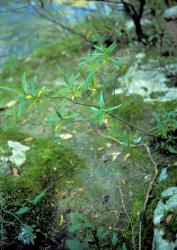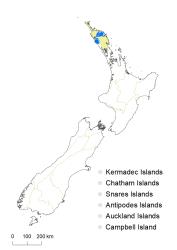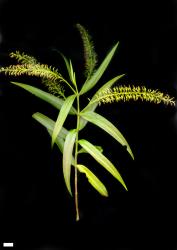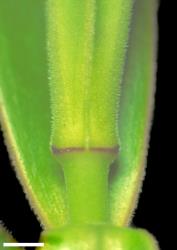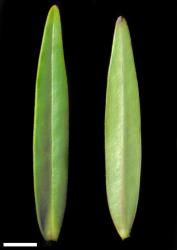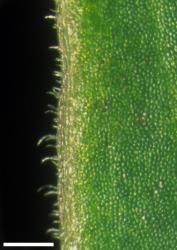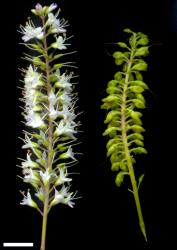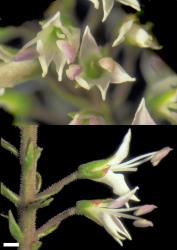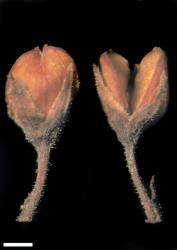- = Veronica acutiflora Benth. in de Candolle, Prodr. 10 460 (1846) nom. illeg., non Veronica acutiflora Lapeyr. ex Roem & Schult. 1817
- ≡ Veronica ligustrifolia var. acutiflora Hook.f., Bot. Antarct. Voy. II. (Fl. Nov.-Zel.) Part I, 192 (1853)
- ≡ Hebe acutiflora (Hook.f.) Cockayne, Trans. New Zealand Inst. 60: 468 (1929)
Open, bushy shrub to 1.5 m tall. Stems sub-erect to erect, eglandular-puberulent; hairs bifarious or uniform. Leaf bud distinct, its leaves appressed at margins until fully grown; sinus absent. Leaves opposite-decussate, erecto-patent to spreading; lamina thin, linear to linear-lanceolate, 15–118 mm long, 3–12 mm wide, dull, green to dark green above, pale green beneath; midrib and faint secondary veins evident; surfaces with eglandular hairs along midrib above and often beneath, and sometimes minute glandular hairs; margin ciliolate, entire or with a few distant, minute, protruding hydathodes; apex acute to obtuse; base cuneate; petiole absent or indistinct, 1–2 mm long. Inflorescence a lateral raceme, 27–136 mm long; flowers crowded, 13–81, all bisexual; bracts alternate to loosely whorled, lanceolate to narrowly deltoid, < pedicels; pedicels erecto-patent to spreading, 2–5 mm long, eglandular-pubescent all around. Calyx lobes 4, acute to acuminate, 1.8–2.5 mm long, equal, eglandular-pubescent on faces, eglandular-ciliate to mixed glandular- and eglandular-ciliate. Corolla 5–7 mm diameter; tube white, 1.3–2.8 mm long, ≤ or rarely slightly > calyx, eglandular-hairy inside; lobes 4, pale purplish to white, erecto-patent to spreading, lanceolate to narrowly ovate, 2.5–4.0 mm long, sub-acute to acute; nectar guides absent. Stamen filaments white, 4.2–6.5 mm long; anthers purplish, sometimes pale. Style glabrous, 3.5–5.5 mm long. Capsules latiseptate, sub-acute to obtuse, usually glabrous, sometimes puberulent on margins and towards apex, 2.0–3.5 mm long, 1.6–3.0 mm at widest point. Seeds ellipsoid to discoid, flattened, smooth, straw-yellow, 0.9–1.4 mm long.
V. rivalis is similar to several other hebes in Northland in the plants having broad, acute corolla lobes and corolla tubes that are about equal to the calyx.
V. flavida plants differ by usually being small trees with mostly broader leaves (30–135 × 6–29 mm) with a distinctive yellow midrib and lamina base, longer inflorescences with more flowers, pedicels that are usually puberulent but may be pubescent, and longer corolla lobes (4.0–5.5 mm).
V. ligustrifolia plants have broader leaves that sometimes may be elliptic or obovate, pedicels puberulent (hairs <50 µm long, cf. 80–100 µm in V. rivalis), and calyx mostly glabrous on outer faces.
Plants of V. stricta have similar hairy calyx lobes, but they have longer corolla tubes and shorter, narrower, and smaller corollas. They usually have broader leaves, mostly in the range 15–30 mm wide in Northland, where V. stricta overlaps with V. rivalis.
Similar narrow leaves are seen in plants of V. angustissima, but that species does not occur in Northland. It differs in puberulent pedicels, often glabrous faces of the calyx lobes, and slightly longer corolla tubes, which narrow somewhat at the throat compared to broadly flaring in V. rivalis.
North Island: Northland (Kerikeri River, Puketotara Stream, Waipapa River and Waipoua River).
River banks, usually in the flood zone. Recorded elevations range from 10 to 300 m.
Flowers: January–June; fruits: January–June, persisting all year.
2n = 40 (see Bayly & Kellow 2006, as Hebe acutiflora).
Veronica rivalis is classified in V. subg. Pseudoveronica sect. Hebe and the informal group “Occlusae” (Albach & Meudt 2010; Bayly & Kellow 2006).
In addition to the localities listed above (see Distribution), there are similar plants from Trounson Kauri Park that differ chemically (discussed by Bayly and Kellow [2006]) and a possible record from Herekino (not mapped here).



